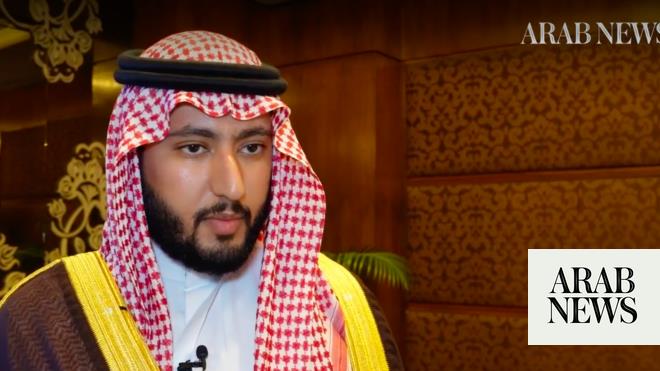
DHAHRAN: On an ordinary November night in 2020, Lina Malaika and Farah Hammad had a conversation that changed their lives.
In the midst of the global pandemic, the pair decided to embark on a business partnership that they hoped would elevate their communities and carve out a new path for them in the business world.
Both women are established in their own right: Malaika has been in the creative industry for over a decade as a filmmaker, designer and entrepreneur; and Hammad is a fashion designer with an acute eye for color and texture and a repertoire that spans several continents.
Modeling is typically more women-dominant but Clay also has five male models. One of them, Abdullah Ali, was raised in Riyadh and joined Clay after being on the scene
independently. His versatile look and aura of confidence allows him to pull off urban and traditional looks flawlessly.
“Basically, me and Lina are talent agents — Clay is the name under us. We are not an agency yet — that’s the plan. Hopefully, we get investors and we become a proper agency. But for now, we are two talent agents,” Hammad told Arab News.
It all started when they met in September 2020, and shortly afterwards decided to launch their business, Clay Models.
It was Malaika’s brainchild. She got her start at Destination Jeddah magazine about a decade ago and then as a creative director at TheLoftMe, a creative studio based in her hometown in the Kingdom’s coastal city. HIGH LIGHTS
• In the midst of the global pandemic, Lina Malaika and Farah Hammad decided to embark on a business partnership that they hoped would elevate their communities and carve out a new path for them in the business world.
• The name ‘Clay’ was the first one that came to Malaika. She wanted a ‘short, playful and versatile’ name that was flexible like a block of clay that one is able to shape. It is a word that could describe makeup, hair, clothing — or modeling.
• As of now, Clay exists mostly in the cloud, literally. Both women have studios, so it is possible to meet in a physical space, but most of the interactions are over the phone. They currently have 30 models on their books but are looking for more
For each of those roles, she needed models for photoshoots and found it quite cumbersome and daunting to constantly curate a database for locally-based models.
It was nonexistent at the time, she said, because many women still needed approval from their families to be photographed, and to have their images in the media was still taboo in many ways.
Malaika then decided to study film in New York and fashion in London before settling back home. She found that she was constantly faced with the same task of finding models for each of her roles and decided to take matters into her own hands. She had a Rolodex of models but wanted it to be more streamlined.
Saudi model Malak Monzer
“I was just always thinking, I have what it takes … all I need is a partner because I can’t do this on my own. Yeah, I’m a creative person but I’m not necessarily a businesswoman,” Malaika said.
Hammad had a similar hurdle each time she had a shoot for her fashion design business.
Raised in multiple countries, splitting her time between Jeddah, Europe and the US, the globe-trotter has a calm steadiness to her. Her attentiveness and empathy toward those around her makes it seem like she collects thoughts and weaves them into the world with an invisible string. She is a doer.
Joining forces seemed like destiny for the two women.
“We’re on the same page, we more or less share the same kind of mentality. So we really understood each other. I don’t remember exactly the conversation, but I was telling her I have this idea to turn this database into a modeling agency.
“And I told her ‘if you don’t do it with me, it’s never gonna happen because I’ve built so many ideas in my head and they never, never come to life.’ I have like a shelf of unfinished ideas. We complete each other in that sense. She started instantly (and) it came to life. She built the website by the next morning. No joke,” Malaika said.
“I was honestly scared and then a bit skeptical because, for me, when I launched my business, my connections — it took years. So when she approached me regarding this, I was like, I’ll get back to you but I think it’s a yes. Then, I was like you know what, I think this is going to be a great opportunity,” Hammad told Arab News.
Saudi Arabia was opening up so they decided to seize the day.
“This was during COVID, remember? At the time, there was this uncertainty in life and there was also like, a lot of ‘we are gonna die.’ And aside from it being a business, it was great for me, and I would say for Farah, too, as a coping tool because we were dealing with parallel personal transitions, and that helped us. It was kind of escapism,” Malaika said.
The name “Clay” was the first one that came to Malaika. She wanted a “short, playful and versatile” name that was flexible like a block of clay that one is able to shape. It is a word that could describe makeup, hair, clothing — or modeling.
“We had (a) lawyer that helped us with the contracts. We wanted the contract to be very flexible, just so it’s fair for everyone and not to stand in the way of the model’s project and life. It was very important for us so the model feels that they can trust us because we’re not there to dominate, we want that relationship with our models and to maintain it, and with our clients, as well,” Malaika told Arab News.
Modeling is typically more women-dominant but Clay also has five male models.
One of them, Abdullah Ali, was raised in Riyadh and joined Clay after being on the scene independently. His versatile look and aura of confidence allows him to pull off urban and traditional looks flawlessly.
“As a self-established model, one of the obstacles that I faced in my early career was the linking point between the talent and the client. Luckily, Clay stepped up and became one of the leading modeling agencies in Saudi Arabia. Even though I had my client base, working with Clay was an advantage to elevating the local industry standards collectively,” Ali told Arab News.
It was important for Clay to offer clients options and to not box any model into any category. Their website has a section for Saudi Arabia, international and male models, with all their specifications. They do not represent anyone under 21.
“Keep in mind, prior to the new Saudi vision, most brands — all luxury brands — would shoot products dedicated to us in the GCC using foreign models. Shots in foreign locations that do not represent us, it does not appeal to us. And slowly, the brands started noticing, like, we need to speak to our clients.
“A lot of them started going to Dubai; it wasn’t acceptable to have models shooting in Saudi Arabia. Brands finally started wanting to use local models in Saudi Arabia, so again, I want to highlight that was very important for us to start this here — it was nonexistent,” Malaika said.
While models are notorious for being divas, they have only encountered one model who misbehaved and disrespected the client by being tardy and having an attitude on set.
They have zero tolerance for unprofessional behavior and they issued a refund to the client with an apology and the model was swiftly fired after giving her a second chance, which she also abused. The brand did return as a customer and it is a testament to their commitment to taking care of the relationship.
“They come back to us because of the type of professionalism we offer and we provide,” Malaika said.
Although the Clay founders still consider their business to be a startup, their stellar reputation in Jeddah and the digital MENA space is evident.
As of now, Clay exists mostly in the cloud, literally. Both women have studios, so it is possible to meet in a physical space, but most of the interactions are over the phone.
“We want to expand and we want to find more talents. (If we) can find more we can find investors to grow … like the sky’s the limit,” Malaika said.
For anyone hoping to land a coveted spot at Clay, professionalism is a must but also an online presence is key. In the digital and social media saturated world, every aspiring model has the ability to open up an Instagram account and share photos.
“It’s very important to have a portfolio. With stylists, designers, photographers — see how they look behind the camera. They might not be photogenic. They should do some research, look at YouTube videos of models, how they pose. To some, it’s just a hobby and they don’t really take it seriously,” Hammad said.
While they do the bulk of the work for quality-control assurance, they have a few freelance agents who help when necessary. So far, they have the same instincts when deciding to let a model join the Clay family and have not yet disagreed on who to sign up.
They currently have 30 models on their books but are looking for more.
The women say they are not doing it for fame but to fill a gap and serve as a platform to elevate the industry.
“Other agencies take a percentage from the model’s rate, we don’t do that, we add our percentage to the model’s rate. The model pays us to do the dirty work — like we’re their agents. We make life easier for the client because everything is done, they don’t have to deal with anything. All they do is book ... So everyone is happy. It’s a win-win situation for the models, and for us and for the client. It’s like a perfect recipe,” Malaika said.












